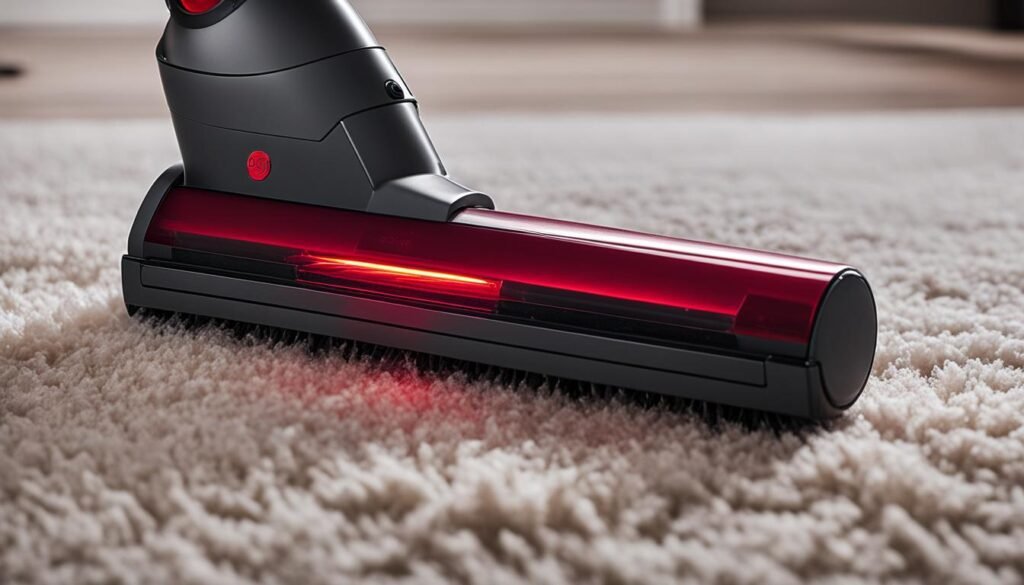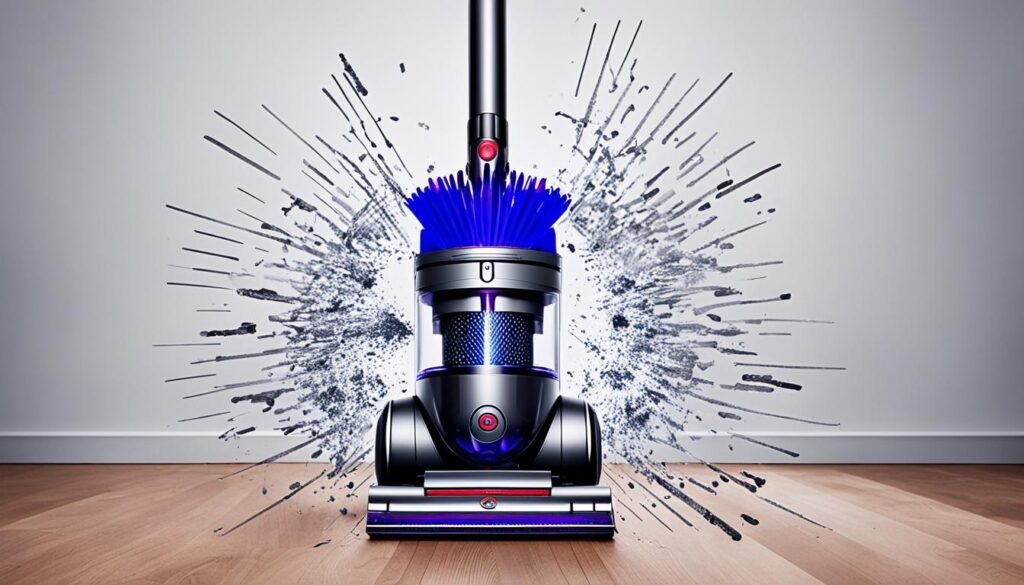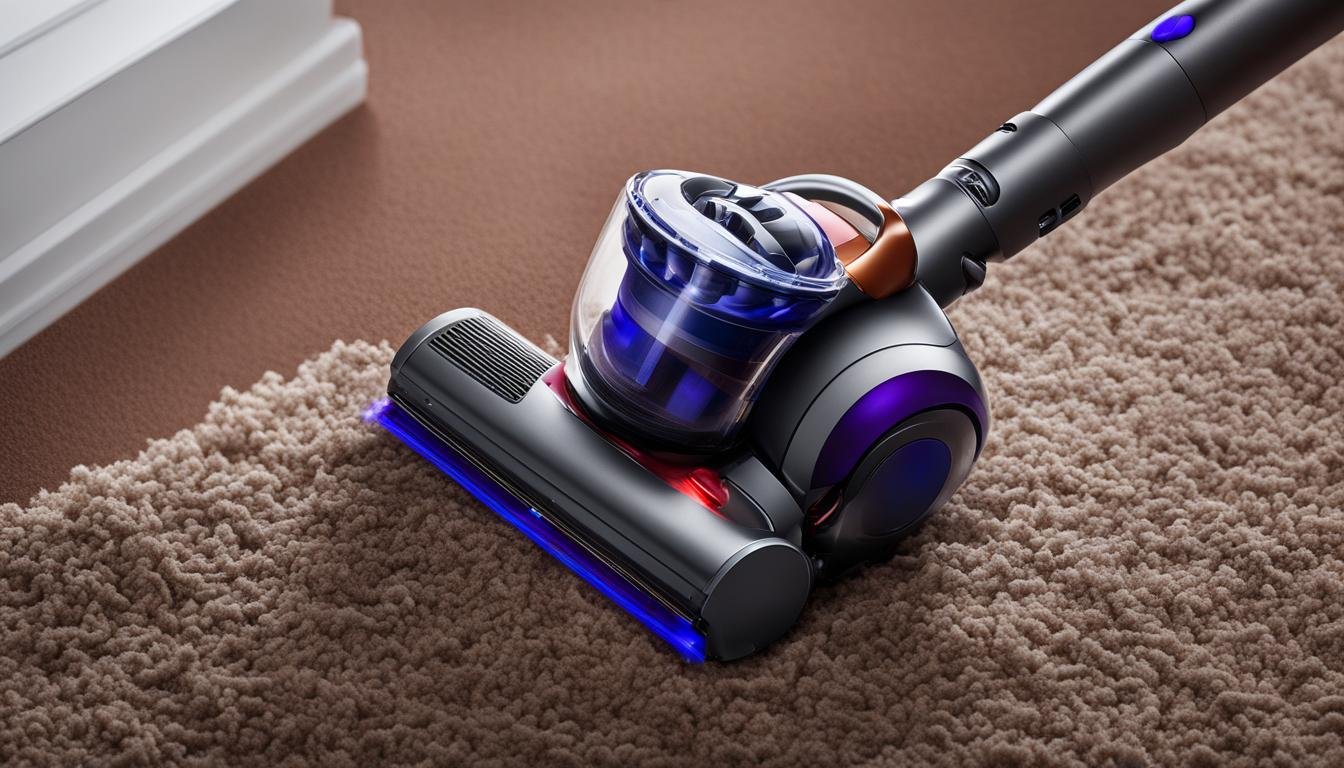Are you annoyed by your Dyson vacuum making a loud noise when you switch it to carpet mode? You’re not alone. Many Dyson users have encountered this issue and have sought solutions to resolve it. In this article, I will explore the various causes of this problem and provide troubleshooting tips to help you quiet down your noisy Dyson vacuum.
Key Takeaways:
- Dyson vacuums may make a loud noise in carpet mode due to various factors such as motor irregularities, brush roll issues, clogging, loose components, and more.
- Troubleshooting the noise issue involves inspecting the brush roll, motor, fan, exhaust, belts, and components for damage or obstruction.
- Regular cleaning and maintenance, including emptying the dustbin, replacing filters, and tightening loose components, can help prevent noise problems.
- Following proper usage guidelines and avoiding large debris can also contribute to quieter operation.
- Taking proactive measures and addressing noise concerns promptly can ensure a quieter and more efficient cleaning experience with your Dyson vacuum.
Troubleshooting Loud Noise Issues in Dyson Vacuums
Are you experiencing a loud noise when using your Dyson vacuum on carpets? Don’t worry, I’ve got you covered! In this section, I’ll guide you through the troubleshooting process to help you fix the loud noise issue in carpet mode.
Step 1: Power Off and Unplug
First things first, always start by powering off and unplugging your Dyson vacuum. Safety should be our top priority!
Step 2: Check for Obstructions
Next, inspect the brush roll area for any obstructions. Sometimes, small objects or tangled hair can interfere with the brush roll’s smooth operation, causing loud noises. Remove any debris or tangles you find.
Step 3: Inspect the Brush Roll
Take a closer look at the brush roll itself. Check for any signs of damage, such as worn bristles or misaligned parts. If necessary, clean the brush roll thoroughly or consider replacing it.
Step 4: Examine the Motor
Is the motor making irregular sounds? A faulty motor can contribute to the loud noise issue in carpet mode. Carefully inspect the motor for any signs of damage or malfunction.
Step 5: Check the Fan and Exhaust
The fan and exhaust system play crucial roles in the vacuum’s operation. Any damage or blockages in these components can result in loud noises. Make sure they are clean and free from any obstructions.
Step 6: Assess the Belts
Inspect the belts for wear or misalignment. Over time, belts can become loose or stretched, causing noise during operation. Replace any worn-out belts and ensure proper alignment.
Step 7: Tighten Loose Components
While examining your Dyson vacuum, pay attention to any loose components. Gently tighten them to eliminate any vibrations or rattling noises that may occur.
Step 8: Test on Different Surfaces
To determine if the noise persists, try using your Dyson vacuum on various surfaces, including hard floors and different types of carpets. This will help you identify if the issue is specific to carpet mode.
| Noise Troubleshooting Checklist |
|---|
| Power off and unplug the vacuum |
| Check for obstructions in the brush roll area |
| Inspect the brush roll for tangles or debris |
| Examine the motor for irregular sounds |
| Inspect the fan and exhaust for damage or blockages |
| Assess the belts for wear or misalignment |
| Check for loose components |
| Test the vacuum on different surfaces |
If, after following these troubleshooting steps, the loud noise issue in carpet mode persists, it might be time to seek professional servicing. Dyson experts can provide further guidance and assistance to resolve the problem.
Remember, addressing and resolving noise issues in your Dyson vacuum will not only improve its performance but also enhance your cleaning experience. Stay proactive and keep your vacuum running smoothly!

Preventive Measures to Reduce Noise in Dyson Vacuums
To minimize the risk of encountering loud noise issues in Dyson vacuums, regular cleaning and maintenance are crucial. By following these preventive measures, you can ensure a quieter operation, enhance cleaning efficiency, and prolong the lifespan of your Dyson vacuum.
1. Empty the Dustbin
Regularly emptying the dustbin helps prevent blockages and ensures optimal suction power. Dispose of the collected dirt and debris properly to avoid any clogs that may lead to increased noise.
2. Clean or Replace Filters
Dirty or clogged filters can restrict airflow and strain the motor, resulting in excess noise. Clean or replace the filters according to the manufacturer’s instructions to maintain optimal performance and reduce noise levels.
3. Inspect and Maintain the Brush Roll
Check the brush roll regularly for hair, fibers, or debris that may cause obstructions. Clear any tangles or blockages to keep the brush roll functioning smoothly, reducing noise and ensuring effective cleaning.
4. Tighten Loose Components
Over time, vibrations and regular use can loosen various components of the vacuum, leading to increased noise. Check and tighten any loose screws, attachments, or parts to minimize vibrations and noise generation.
5. Use the Vacuum Properly
Proper usage techniques can help reduce noise levels. Avoid pushing the vacuum too forcefully or dragging it across surfaces, as this may cause unnecessary noise. Follow the manufacturer’s instructions for optimal usage and maneuvering.
6. Adjust for Different Surfaces
Some surfaces may require adjustments to the vacuum’s settings to avoid excess noise. Be sure to adjust the height settings or switch to appropriate cleaning modes for carpets, hardwood floors, or other surfaces to ensure optimal performance and minimize noise.
7. Avoid Large Debris
Avoid vacuuming large debris that may cause blockages or damage to the vacuum’s components. Clear away larger items before vacuuming to reduce the risk of noise and potential damage to the machine.
8. Store the Vacuum Properly
When not in use, store the vacuum in a clean and dry area to prevent dust accumulation and potential damage to the motor or other parts. Proper storage helps maintain the vacuum’s performance and minimizes noise issues.
By adopting these preventive measures, you can ensure a quieter cleaning experience with your Dyson vacuum. Regular maintenance and careful usage will not only reduce noise levels but also contribute to the vacuum’s longevity and overall efficiency.
| Preventive Measures | Benefits |
|---|---|
| Empty the dustbin | Prevents clogs and maintains suction power |
| Clean or replace filters | Optimizes airflow and reduces strain on the motor |
| Inspect and maintain the brush roll | Prevents obstructions and ensures effective cleaning |
| Tighten loose components | Minimizes vibrations and noise generation |
| Use the vacuum properly | Reduces force and dragging that may cause noise |
| Adjust for different surfaces | Optimizes performance and reduces noise on various surfaces |
| Avoid large debris | Prevents blockages and potential damage |
| Store the vacuum properly | Maintains performance and reduces dust accumulation |

Conclusion
The issue of Dyson vacuums making loud noise in carpet mode can be quite frustrating for users. However, by understanding the potential causes and following the troubleshooting steps, you can identify and resolve the underlying issues.
To fix the loud noise in carpet mode, start by checking for any obstructions in the brush roll area and ensure that the brush roll is free from tangles or debris. Inspect the motor, fan, and exhaust for any damage or blockages that may be causing the noise. Additionally, assess the belts for wear or misalignment and tighten any loose components that you may find. Testing the vacuum on different surfaces can help determine if the noise persists and if further investigation or professional servicing is required.
Preventive measures are key to reducing noise in Dyson vacuums. Regular cleaning and maintenance, such as emptying the dustbin, cleaning or replacing filters, and inspecting and maintaining the brush roll, can help prevent noise problems. Using the vacuum properly, adjusting for different surfaces, and avoiding large debris can also contribute to a quieter and more efficient cleaning experience. By taking proactive measures and addressing noise concerns head-on, you can ensure a quieter and smoother operation of your Dyson vacuum, preserving its reputation for excellence in cleaning technology.
FAQ
Why is my Dyson vacuum making loud noise in carpet mode?
The loud noise issue in carpet mode can be caused by various factors such as motor irregularities, brush roll issues, clogging in the suction pathway, loose components, fan problems, belt issues, foreign objects, worn bearings, exhaust blockages, and lack of lubrication.
How can I troubleshoot loud noise issues in my Dyson vacuum?
To troubleshoot loud noise issues, start by powering off and unplugging the vacuum. Check for obstructions in the brush roll area, inspect the brush roll for tangles or debris, examine the motor for irregular sounds, inspect the fan and exhaust for damage or blockages, assess the belts for wear or misalignment, check for loose components, and test the vacuum on different surfaces to determine if the noise persists. If the issue cannot be resolved, seek professional servicing.
What preventive measures can I take to reduce noise in my Dyson vacuum?
To minimize the risk of encountering loud noise issues, regularly clean and maintain your Dyson vacuum. Empty the dustbin, clean or replace filters, inspect and maintain the brush roll, tighten loose components, use the vacuum properly, adjust for different surfaces, avoid large debris, and store the vacuum properly. These preventive measures help ensure quieter operation, enhance cleaning efficiency, and prolong the vacuum’s lifespan.





Leave a Reply